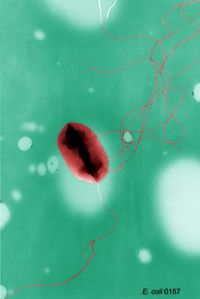EHEC

Etiology/Bacteriology
Taxonomy
| Domain = Bacteria | Phylum = Proteobacteria | Class = Gammaproteobacteria | Order = Enterobacteriales | Family = Enterobacteriaceae | Genus = Escherichia | species = E. coli | subspecies = O157:H7 | prototype strain = EDL933 |
|
NCBI: Taxonomy Genome: Escherichia coli O157:H7 str. EDL933 |
Description
Escherichia coli O157:H7 is an emerging pathogen that causes hemorrhagic colitis. E. coli is a Gram negative rod, a facultative anaerobe motile by means of peritrichous flagella, and found in the GI tract of mammals. Most E. coli are harmless and actually are an important members of a healthy human intestinal microbial community. However, E. coli is a very diverse group of bacteria consisting of many ecotypes (the harmless variety) and pathotypes. The pathogenic strains of E. coli can cause diarrheal diseases, urinary tract infections, and even meningitis. The E. coli pathotypes that cause diarrhea are transmitted via contaminated food or water, or through contact with infected animals or people. E. coli O157:H7 was first reported by the CDC in 1982. [1] E. coli O157:H7 is one of several pathotypes classified as enterohemorrhagic E. coli (EHEC). EHEC cause disease by producing a toxin called Shiga toxin, Shiga toxin causes bloody diarrhea and in approximately 5-10% of cases hemolytic uremic syndrome (HUS), which can lead to complete kidney failure. Patients with bloody diarrhea usually recover within a week and those who develop HUS usually recover within a few weeks, but in cases of kidney failure the patient may die. While people of any age are susceptible, the young and elderly are more often affected. Treatment of EHEC typically involves rehydration without administration of antibiotics and hospitalization in severe cases, especially HUS. EHEC infection is prevented by good hygiene, proper cooking of food, not swallowing water while swimming, and avoiding unpasteurized milk or apple cider. The prototypical E. coli O157:H7 strain is EDL933, which was isolated from Michigan ground beef that was linked to the original 1982 outbreak. The E. coli EDL933 genome was sequenced in 2001. [2] This strain of O157:H7 has been used in hundreds of scientific studies.
Pathogenesis
Clinical features
Diagnosis
Treatment
Prevention
Host Immune Response
References
1 Centers for Disease Control (CDC). Isolation of E. coli O157:H7 from sporadic cases of hemorrhagic colitis - United States. MMWR Morb Mortal Wkly Rep. 1982 Nov 5;31(43):580, 585. PubMed PMID: 6817062. 2 Perna NT, Plunkett G 3rd, Burland V, Mau B, Glasner JD, Rose DJ, Mayhew GF, Evans PS, Gregor J, Kirkpatrick HA, Pósfai G, Hackett J, Klink S, Boutin A, Shao Y, Miller L, Grotbeck EJ, Davis NW, Lim A, Dimalanta ET, Potamousis KD, Apodaca J, Anantharaman TS, Lin J, Yen G, Schwartz DC, Welch RA, Blattner FR. Genome sequence of enterohaemorrhagic Escherichia coli O157:H7. Nature. 2001 Jan 25;409(6819):529-33. PubMed PMID: 11206551.
Created by Tyrrell Conway at the University of Oklahoma.
